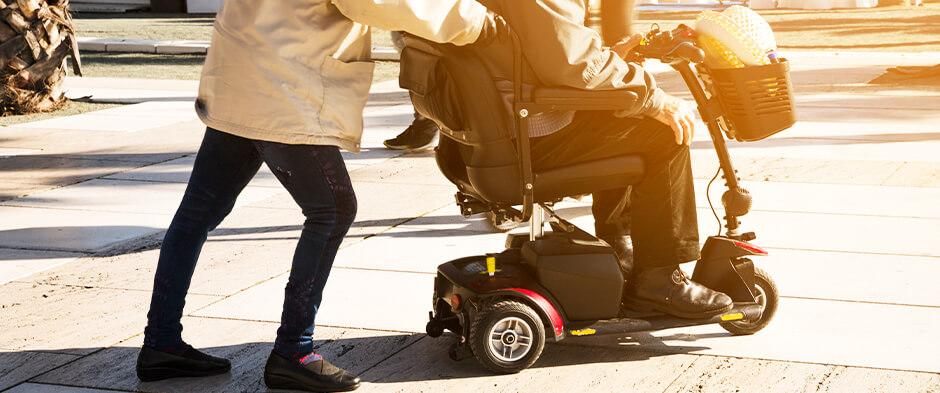
A Short Guide to Types of Walking Aids Available for Elderly People
Sally Madeley-Carr, OT13 Apr 2020
People in the UK are living longer than ever before. While it's nice to look forward to being around well into old age, it does provide its own challenges. A reduction in one's mobility is an issue encountered by more people than ever, so it's important to consider ways in which its effects can be mitigated.
Common conditions like arthritis and others which affect the body's joints or dexterity can have a dramatic impact on our lifestyle. Most people take their mobility for granted and it can come as a shock when it's compromised.
With the vast majority of people determined to stay in their own homes and leading independent lives in later life, it's important to be open-minded about equipment which will help facilitate it.
Indeed, the UK government has repeatedly made clear that a priority is to ensure people are able to stay in their own homes for as long as possible in old age. This is important as budgets are increasingly channelled in this direction, providing help and assistance to those who may not be able to afford to buy equipment privately.
According to official figures, by 2040 the number of people in the UK aged over 85 is set to top 2.7 million. At around 1.5 million in 2020, this represents a huge increase. In 2040 the number of disabled older people is projected to be 5.9 million.
The section of population over 85 is the one most likely to require healthcare services. In the 65-69 age bracket, about 15% of people experience difficulty undertaking routine activity, while in the bracket of those older than 85, this rises to over 30%.
With all this in mind, access to equipment which is likely to help maintain someone's ability to get around unaided is important. While large items like mobility scooters are becoming popular, it is the smaller more affordable products which most people turn to first.
Modern walking aidscome in numerous guises, from simple equipment like walking sticks and canes, to rollators and other wheeled support equipment.
Here we'll go through some of Essential Aids' most popular categories of walking aid.
Walking sticks
Perhaps the longest-serving mobility aid around, the stick provides a lightweight aid to help support you as you walk. Traditional walking sticks have been joined by modern designs which tend to be made of lightweight metal, usually aluminium.
This is an excellent material for walking stick tubing because as well as its weight, it is also non-corrosive and relatively rigid.
Aluminium walking sticks usually have two shafts, one of which slides inside the other. This allows you to adjust the overall length by means of a pin-clip mechanism.
This type of walking stick comes with a plastic handle. In some cases these are available with a contoured 'ergonomic' shape. Fitting the curvature of the palm and fingers, spreading weight evenly and making the stick more comfortable.
One problem with conventional walking sticks is the narrowness of the handle, which have a tendency to dig into the palm. This can be particularly painful for people suffering with arthritis in the hands, a common condition in old age. Contoured handles can dramatically improve comfort, so are increasingly popular.
Wooden sticks are favoured by some because of their aesthetically pleasing appearance. They need to be cut down to the required length.
Both wooden and aluminium sticks need a rubber or plastic foot, known as a ferrule. These provide a soft, high friction tip which prevents slippage on hard surfaces.
Another useful accessory is a bag or clip which allows you to fix a walking stick to a wheelchair, rollator and man mobility scooters.
Folding walking sticks are great for packing into handbags or rucksacks when need be. Sticks like this tend to be made up of three sections of metal tubing with a flexible cord running through the centre.
The three sections lock together when in use, but are easily pulled apart when the stick is folded down, with the cord keeping the sections from falling fully apart.
This type of folding stick is not as rigid or strong as non-folding versions, but is a good choice if you only need to use it occasionally.
Walking sticks with three or four legs
Tetrapod and tripod walking sticks offer a bit more in the way of support than a standing stick.
Again, aluminium is the metal of choice and typically these devices come with a length-adjustment, pin-clip mechanism found on standing metal walking sticks.
Available with four legs (tetrapod) or three (tripod) they have an important benefit of standing upright on their own.
This is significant for those who might have difficulty bending down to pick things up from the floor and for whom a fallen walking stick could present problems.
In terms of stability, the four-legged models tend to be the best, with the three-legged ones lighter in weight and slightly easier to manoeuvre.
Generally speaking both versions are used mostly indoors, but can in some cases may be taken outside.
Like regular walking sticks, they have non-slip ferrules on each leg. Some designs also feature a curved shaft, which improves the way weight is distributed and maximises stability.
Walking frames
If a multi-legged walking stick isn't providing enough support, you might consider a walking frame. Commonly known as 'zimmer frames' in the UK after the original manufacturer, these offer a tubular box-like support frame with four feet.
Standard models are made from aluminium and can be set to the desired height by adjusting the length of the four legs. Like walking sticks, the 'feet' of walking frames have plastic or rubber ferrules to stop them slipping.
'Bariatric' walking frames for heavier individuals are made from steel and are stronger than standard models.
Most people will be familiar with the design of a walking frame, with the two handles positioned on either side of the top tubing. These provide a balanced and stable support point to help the user walk.
In order to move, the user slides or lifts the frame forward, then takes a step to catch up with it. It can be slow progress, but offers stable support on both sides of the body, unlike a walking stick.
The plastic hand-grips are usually wide and contoured, making them easier on the hands. This is important if you have arthritis in this area of the body.
Some walking frames have two small wheels at the front. This makes it smoother to edge the walker forward.
Wheeled walkers and rollators
Rollators are robust walking aids for elderly people who have difficulty with their mobility. They are available with two or three wheels and most types are suitable for outdoor or indoor use.
Like a walking frame, a rollator walker delivers mobile support but is more robust and has larger wheels. The tri-wheeled versions tend to be easier to manoeuvre, while four wheelers are the most stable.
Most four wheeled models come with an integral seat. This provides a convenient place to rest if required. There is often a basket built-in beneath the seat, which is great for holding shopping.
Many three-wheelers also have bags to carry shopping, normally in the shape of a smaller holdall which attaches between the handlebars.
Brakes on rollators usually work in a similar way to those on a bicycle. Some also engage when the user sits on the seat, ensuring it can't roll away without warning.
Both steel and aluminium rollators are available at Essential Aids. The steel models are stronger, while aluminium offers lighter weight and does not corrode as readily.
Tyres on rollator walkers are solid rather than pneumatic in order to minimise the possibility of the equipment becoming immobile from a puncture.
Crutches
While crutches tend to be seen in recovery after injury, some people use them as a general mobility aid. Essential Aids does a range of high quality, excellent-value crutches, both in the underarm and forearm styles.
The forearm versions are the most common, easily adjusting to the person's height and limb length.
For those using them as a long-term mobility aid, the permanent user crutches are a good option. While standard models are size-adjustable via two shafts and a pin-clip, these have a single shaft.
This shaft needs to be hacksawed down to the correct length. Once this is done, it creates a more rigid and solid feeling than adjustable crutches. This means the Essential Aids permanent user crutches do not come with the squeaks and rattles associated with the multi-adjustment models.
Of course, walking aids around the home can be used in combination with things like grab rails, stairlifts, shower stools and other aids. Used together, the domestic environment can remain accessible and safe.
Outside, the growing popularity of mobility scooters shows more and more people are prepared to do what it takes to transport themselves independently.
Having the awareness and a desire to use all the tools and equipment at our disposal will make the task of maintaining independence in old age an easier one. Retaining the ability to walk unaided is a key part of this and Essential Aids continues to be a major provider of mobility equipment to the UK public.

Sally Madeley-Carr, OT
Sally qualified as an Occupational Therapist in 1996 and is a well-respected professional in the field of rehabilitation equipment and living aids. She has worked in private practice and within the NHS, developing a broad experience with adults and children. Click here for Sally's registration with the Health and Care Professions Council. The HCPC regulates health, psychological and social work professionals in the UK.